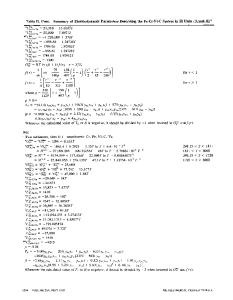Thermodynamic Assessment of the Ru-Zr Binary System
- PDF / 396,134 Bytes
- 7 Pages / 593.972 x 792 pts Page_size
- 59 Downloads / 435 Views
Basic and Applied Research: Section I
Thermodynamic Assessment of the Ru-Zr Binary System M. Idbenali, C. Servant, N. Selhaoui and L. Bouirden
(Submitted November 9, 2006) The Ru-Zr system has been assessed by means of the Calphad approach. The solution phases (Liquid, (Ru), (aZr) and (bZr)) were modeled with the sublattice formalism and the excess term of the Gibbs energy with the Redlich-Kister equation. The intermetallic compounds Ru2 Zr and RuZr, which have homogeneity ranges, were treated as the formula (Ru,Zr)0:667 (Ru,Zr)0:333 and (Ru,Zr)0:5 (Ru,Zr)0:5 by a two-sublattice model with a mutual substitution of Ru and Zr on both sublattices. The calculated phase diagram and the thermodynamic properties of the system are in satisfactory agreement with the experimental data.
Keywords
Calphad method, phase diagram, Ru-Zr system, thermodynamic assessment
1. Introduction The phase diagram of the Ru-Zr system was investigated by Raub and Ro¨schel[1] then by Eremenko et al.[2,3] using metallography, x-ray diffraction, and differential thermal analysis. The recent evaluation performed by Okamoto[4] is shown in Fig. 1. The equilibrium phases include: (1) the liquid, L; (2) two intermediate phases Ru2 Zr and RuZr ; and (3) the three terminal solid solutions (Ru), ðaZrÞ and ðbZrÞ. This present work deals with an assessment of the thermodynamic description of the Ru-Zr system using the CALPHAD technique[5]. In this method, the thermodynamic models for the Gibbs energy of all the individual phases are studied using the Parrot module in the ThermoCalc Software package[6]. The thermodynamic parameters involved in the models are optimized from the experimental thermodynamic and phase diagram data.
2. Thermodynamic Data Many authors determined the enthalpies of formation for the intermetallic compounds of the Ru-Zr system; the results are collected in Table 1. Topor and Kleppa[8] measured the standard enthalpy of formation of RuZr using the solutesolvent drop method. Watson et al.[10] employed the Linear
M. Idbenali, N. Selhaoui, and L. Bouirden, Laboratoire de Thermodynamique Me´tallurgique et Rhe´ologie des Mate´riaux, Universite´ Ibn Zohr, B.P. 496 Dcheira, Agadir, Morocco; C. Servant, Laboratoire de Physicochimie de lÕEtat Solide, ICMMO, Baˆt 410-415, Universite´ de Paris-Sud, Orsay Cedex 91405, France; Contact e-mail: [email protected]
Augmented Slater-Type Orbitals (LASTO) band calculations. Furthermore de Boer et al.[11] and Colinet et al.[9] calculated by a semiempirical model the enthalpies of formation of RuZr and Ru2 Zr. More recently, Mahdouk et al.[7] measured the enthalpies of formation of RuZr and Ru2 Zr by a calorimetric method and attempted to assess the phase diagram using the software NancyUn elaborated by Charles[14]. This routine is less powerful than the Thermocalc software because it took into account only the liquid and the intermetallic phases and the terminal solid solutions (Ru), ðaZrÞ and ðbZrÞ were not modeled. In the assessment by Mahdouk et al.[7] no invariant reaction appears on the Z
Data Loading...











